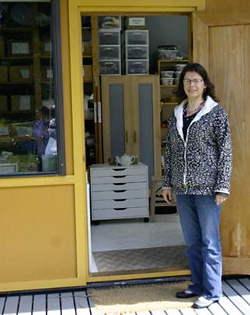By Susan Riemer, Staff Writer. Originally published in the Vashon-Maury Island Beachcomber, Wednesday, April 21, 2010

Susan Riemer/Staff photo. Lidunn Øverdahl Cain stands at the doorway to her studio outside of her home on Cemetery Road. Her husband and father built the studio last winter. The light-filled studio is testament to her practical nature. The left side serves as her architecture studio while the right serves as her sewing space for Buddhist robes and cushions.
Small changes in homes can have a big impact on the inhabitants.
After a several-yea hiatus, Islander Lidunn Øverdahl Cain is returning to her work as an architect, hoping to bring her training and Norwegian sensibilities to a practice that includes a focus on making homes with challenging or small spaces work well.
Øverdahl Cain, who was born and raised in Norway, would welcome designing a new home as well. But she said her knowledge and interests lend themselves well to an architectural practice that will likely be a good fit for today’s issues — including making projects both economical and environmentally sensitive.
“In Norway, people do not move as much as they do here,” she said, but rather, as families’ situations change, they change their homes, an approach, she said, that makes sense for many people now and can entail just a modest amount of work.
“Often with very small changes, you can improve the quality of life in a house a lot,” she said.
Also in Norway, as in much of Europe, people’s homes are smaller than the homes in the United States, with rooms serving multiple purposes. This approach also makes sense to Øverdahl Cain, who noted that she is “almost hardwired for practicality.”
When working with clients, she likes to understand how they live in their home and wants the details of how they live and what is important, she said: “Do you have small children? What do they need now, five years from now? How does the house work if your partner has the flu, and you have a friend over? You come home with tons of groceries, and where do you walk? What do you see? Do you entertain a lot, do you cook or don’t cook? The house should reflect the way people live.”
Indeed, finding solutions lies at the heart of her work. “What I love most about architecture is the interactions between the client and me, really listening deeply to what they are saying, understanding it and giving it back in a physical form and hopefully even exceeding what they dreamed about. Finding the solution is almost like solving a mystery.”
While many people think architects and their services are most appropriate for large projects, Øverdahl Cain said that is a common misconception and that she is happy to work with people simply to get them off on the right foot.”
I’m really happy to go in and talk to you for two to three hours and explore possibilities. I think that is a lot of fun to do,” she said. And it often pays off down the road, she noted. “It is so much cheaper to make a mistake on paper than in real life.”
Øverdahl Cain grew up in Oslo with an architect father. She received a master’s degree in architecture there in 1990 and worked there as an architect until 1998, when she left for what was supposed to be a few months at Mount Baldy Zen Center in California.
“I went for a summer and stayed a little bit longer and a little bit longer and a little
bit longer, then I fell in love,” she said.
In 1999, she and Koshin Chris Cain married; he is the abbot of the Puget Sound Zen Center on Vashon. They have two young children and a home- and Internet-based business making and selling meditation cushions and Buddhist robes.
Buddhism, she said, has affected her work as an architect by making her a better listener and keeping her unattached to her ideas — a useful trait whose seeds were first planted by her architect father.
“You’re used to ideas getting thrown out the window,” she said. With her children getting a little bit older, this is her time to return to her professional roots and solve the mysteries of designing homes that truly fit the individuals who live in them. “Now I figure it’s my turn to do what I really love. I really love architecture,” she said.